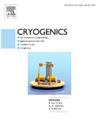纯扭转模式下卷对卷紫外皮秒激光切割制备的YBCO多丝带载流性能退化研究
IF 2.1
3区 工程技术
Q3 PHYSICS, APPLIED
引用次数: 0
摘要
YBCO多丝带的载流性能在电缆和磁体制造过程中容易受到扭转应力的影响。本研究以上海超导科技有限公司生产的YBCO商用胶带为材料,采用本课目研制的卷对卷紫外皮秒激光切割装置,分别制备了2丝、6丝和10丝多丝胶带。此外,部分多纤带采用本课题组开发的镀铜再封装工艺进行封装。系统分析了纯扭转模式下无条纹带、未封装多丝带和再封装镀铜多丝带载流性能的退化行为。结果表明,多丝带的降解行为与多丝带的数量密切相关。其中,当剪切应变达到0.4125%时,未封装的无条纹带和未封装的2丝带的临界电流降解率分别为12.11%和12.43%。相比之下,未封装的6丝带和未封装的10丝带在较低应变(0.375%)下的降解率分别为11.69%和20.96%。对于厚度为10 μm的单面镀铜重包覆样品,其性能下降模式与镀铜重包覆前基本一致,但其整体抗剪切应变能力提高了约0.1%。宏观观察表明,扭转后胶带表面保持光滑,无分层现象;然而,“三角形”变形特征显示出内部应力分布不均匀,表明超导层可能发生了微观损伤。本文章由计算机程序翻译,如有差异,请以英文原文为准。
Study on the degradation of current-carrying performance of YBCO multi-filamentary tapes prepared by reel-to-reel ultraviolet picosecond laser cutting under pure torsion mode
YBCO multi-filamentary tapes’ current-carrying performance is susceptible to torsional stress during cable and magnet fabrication. In this study, commercial YBCO tapes from Shanghai Superconductor Technology Co., Ltd. were cut using a reel-to-reel ultraviolet picosecond laser cutting device developed by our group to fabricate 2-filament, 6-filament, and 10-filament multi-filamentary tapes. Additionally, some of the multi-filamentary tapes were encapsulated using the copper-plating re-encapsulation process developed by our group. The current-carrying performance degradation behavior of non-striated tapes, unencapsulated multi-filamentary tapes, and re-encapsulated copper-plated multi-filamentary tapes under pure torsion mode was systematically analyzed. The results show that the degradation behavior of multi-filamentary tapes is strongly dependent on the number of filaments. Specifically, the critical current degradation rates of unencapsulated non-striated tapes and unencapsulated 2-filament tapes are 12.11 % and 12.43 % respectively when the shear strain reaches 0.4125 %. In contrast, unencapsulated 6-filament and unencapsulated 10-filament tapes exhibit degradation rates of 11.69 % and 20.96 % respectively at a lower strain (0.375 %). For samples subjected to single-side copper-plated re-encapsulation with a thickness of 10 μm, the pattern of performance degradation is essentially consistent with that of the samples before copper-plated re-encapsulation, but their overall ability to withstand shear strain is improved by approximately 0.1 %. Macroscopic observations indicate that the surface of the tapes remains smooth without delamination after torsion; however, the “triangular” deformation feature reveals uneven internal stress distribution, suggesting that the superconducting layer may have incurred microscopic damage..
求助全文
通过发布文献求助,成功后即可免费获取论文全文。
去求助
来源期刊

Cryogenics
物理-热力学
CiteScore
3.80
自引率
9.50%
发文量
0
审稿时长
2.1 months
期刊介绍:
Cryogenics is the world''s leading journal focusing on all aspects of cryoengineering and cryogenics. Papers published in Cryogenics cover a wide variety of subjects in low temperature engineering and research. Among the areas covered are:
- Applications of superconductivity: magnets, electronics, devices
- Superconductors and their properties
- Properties of materials: metals, alloys, composites, polymers, insulations
- New applications of cryogenic technology to processes, devices, machinery
- Refrigeration and liquefaction technology
- Thermodynamics
- Fluid properties and fluid mechanics
- Heat transfer
- Thermometry and measurement science
- Cryogenics in medicine
- Cryoelectronics
 求助内容:
求助内容: 应助结果提醒方式:
应助结果提醒方式:


